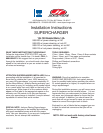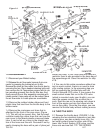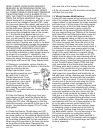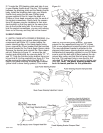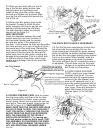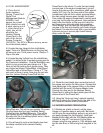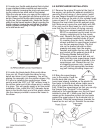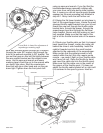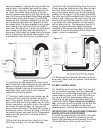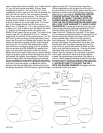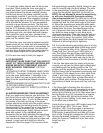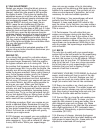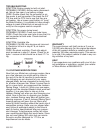
9.7 IDLE ADJUSTMENT:
Restart your engine. Using the idle air screw on
your throttle body (now on the back of the super-
charger), adjust your idle speed to 950 rpm after
the engine is warm. This is done by backing the
adjustment screw out a half turn at a time until the
correct speed is achieved (counter-clockwise rota-
tion increases idle speed). Next, turn your head-
lights on BRIGHT and put your heater fan on
HIGH. Leave the air conditioning off. Rev the
engine briskly in neutral to at least 2500 rpm and
release. Notice if the idle stops at 900 rpm. If it dips
below this level and feels like it will stall, then recov-
ers to 950 rpm, open the idle airscrew (counter-
clockwise rotation) one tenth of a turn at a time until
most of this “droop” disappears. A slight droop of
100 rpm or so is acceptable and normal. More than
that may create a stalling problem during driving.
Turn off the lights and heater fan and double check
that your idle speed is 950 rpm.
FUEL QUALITY
It is recommended that unleaded gasoline of 91
octane rating or better should be used when your
Miata is supercharged.
DRIVING TIP:
If you should find yourself in a situation where
you cannot find high-octane fuel, you can bypass
the supercharger temporarily. Note the position
the bypass actuator arm is in during idle. This is
the position that bypasses the boost air back into
the supercharger inlet. As you blip the throttle, the
actuator arm will move and close a butterfly valve
inside the bypass manifold. Using a short piece of
wire, fix the bypass actuator arm in the “bypass”
position that it holds at idle. This will prevent
boost from being developed and thus, detonation
will not occur. Of course, your engine will now run
like a stock Miata’s, but will be quite operable for
as long as you need. When you find higher-
octane fuel, simply remove the wire to release the
actuator arm and the bypass will function normal-
ly, closing during acceleration, bypassing during
idle and cruise. Try to run the low octane fuel out
of your tank before filling up. Mixing fuels of differ-
ent octane will lower the overall rating and deto-
nation could still be a problem.
9.8 Starting procedure: Start your engine as you
would a standard Miata. Remember to bring the
engine up to operating temperature (as indicated
by your water temperature gauge) before running
it hard. Full boost on a cold engine will greatly
increase your engine wear.
9.9 Oil changes: we suggest you use synthetic oil
such as Mobil 1 and change it regularly (5000
miles maximum). If you use a mineral oil, change
it every 2500 miles. While your supercharger
does not use any engine oil for its lubrication,
your engine will be working a little harder with the
addition of a supercharger. The synthetic oil pro-
vides an extra measure of protection, but is not
necessary for safe and reliable operation.
9.9.1 Breaking-in: Your supercharger will work
perfectly from the first time you fire it up.
However, it does need about 500 miles to fully
seat the rotors. Up to that time, you may notice a
slight noise coming from the supercharger at idle.
This is normal.
10.0 Performance: You will notice that your
engine runs stronger during cold days than on
very hot ones. This is due to the nature of the
internal combustion engine. When the air is cold,
the engine receives a denser charge of air, thus
more power can be produced. While this is true
with any engine, the supercharger amplifies this
cold air benefit.
10.1 BELTS
The only item to watch with your supercharger
system will be the belt tension for the supercharg-
er drive. If you have a tension gauge for a poly-
vee belt, the tension is to be 90 pounds. Without
a gauge, look for less than 1/2” deflection on the
long run of the belt. If you see a large accumula-
tion of belt dust on your supercharger, it is an
indication that your belt is slipping. A slight
amount of belt dust is normal.
CHECKING YOUR BELT FOR WEAR: As the belt
wears, small cracks will form in each of the ribs
on the inside run of the belt. Replace your belt
when you can count six cracks within one inch of
length (six cracks total from all ribs combined).
10.2 Every six months or so, check your hose
clamps for correct tension. The rubber hoses will
take a set and the clamps may not be holding as
tight. Also check all mounting bolts and nuts, par-
ticularly the throttle cable anchor bracket.
10.3 Your air filter is a long-life unit needing serv-
ice only every 15,000 miles. To clean, you can
wash the filter element in soap and water. Use a
dish detergent soap such as Dawn, etc. Rinse
thoroughly and allow to dry. Wet the filter element
with a light application of ATF (automatic trans-
mission fluid). Alternatively, a special cleaning kit
is available (901-970)
10.4 At every oil change, lubricate the bypass
actuator arm contact point and shaft bushing with
light grease to insure long life - these parts are
exposed to underhood dirt and grime.
13
1/07999-200



